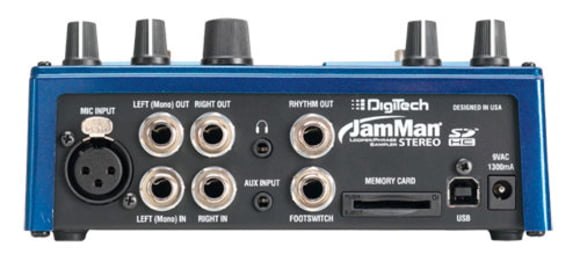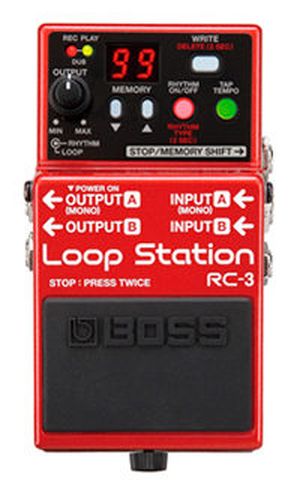2. Working Principle
Loopers are very close relatives of the classic delay: both record an incoming signal, save it, and then play it back in the loop. While the delay fades over the repetitions, however, simulating the natural decay of sound energy, loopers keep playing back the recorded phrase at identical volume, and they do so until you actively stop playback.
Thus, the looper rather resembles a sampler in this sense, a device that keeps playing back the sampled phrase in the loop until the trigger signal is discontinued.
A looper is a kind of live sampler which gets by without a keyboard and which (as a rule) does not allow changes in playback pitch. To do so, the looper contains an internal flash memory which can store AD-converted audio data: even compact floor effects devices leave the factory with a memory capacity of more than 1.7GB (e.g. Boss RC-3) which provides space for 99 or even more monophonic or stereophonic phrases. The maximum size of a phrase is usually limited only by the storage size: if needs be, you can "abuse" a suitably equipped looper to record three hours of audio material in stereo - CD quality, naturally!
In addition, you can expand these already considerable boxes with SD cards in order to integrate pre-produced loops in .wav format (16 or 24 bit, 44.1 kHz). If you're looking for even more convenience, you can hook up your looper to your PC at home and manage the memory with a dedicated piece of software, as is possible with the Digitech JamMan devices, for example: they allow you not only to move data from the computer to the looper, but also to generate performance playlists and to backup the looper's memory to your hard disc.

Looper rear side
To operate a looper, you mainly need a switch function which allows you to communicate all necessary commands (recording start/stop, playback start/stop). Since loopers are primarily conceived for live performance, the switch function usually takes the shape of foot pedals which have to be operated according to particular patterns or durations to trigger the various functions.
| Caution: Even if you are dexterous with your feet, you need to practice operating your looper, otherwise you may well delete a recorded loop instead of enhancing it with an overdub. |
"Overdubbing" is also the key word for a truly satisfying performance: soloists in particular will not be happy with a single phrase as the backing for their solo flights. That's why overdubbing offers the option to play back more material in addition to the current loop while recording it at the same time. This so-called overdub is then used as the new loop and can be expanded at will by further overdubbing. And even if a bar or two may not have come out as desired, this does not spell catastrophe for your performance: thanks to the undo function, you can simply eliminate the last recorded phrase without deleting the other loops/overdubs.



